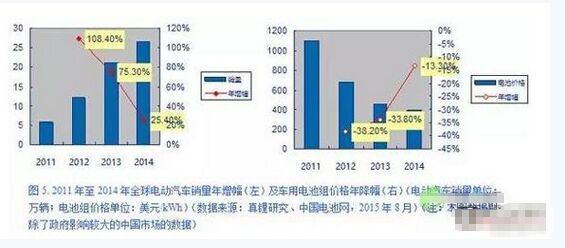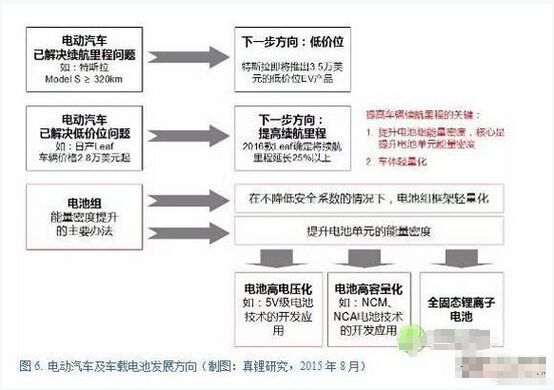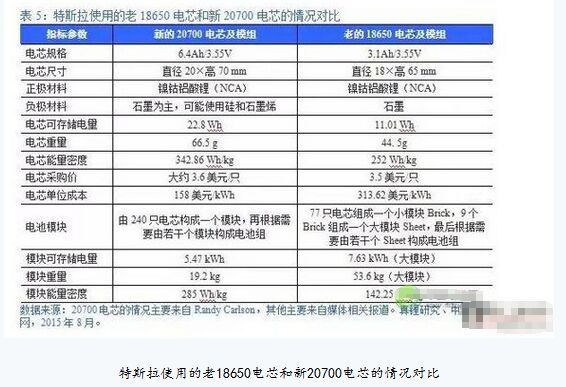Since the electric vehicle market is the most important driving force for the development of the lithium-ion battery industry in the future, here we will briefly look at the development trend of electric vehicles and vehicle batteries in the next few years. In view of the fact that the battery is the core component of electric vehicles, the proportion of batteries in the production cost of pure electric vehicles is also the highest, generally more than 30%, and some even 40% or more. Since the first year of commercialization of electric vehicles in 2011, the sales of electric vehicles have been closely related to changes in battery prices, as shown in Figure 1.
This article refers to the address: http://

As can be seen from Figure 1, the price of the car battery pack decreases by 10%, and the sales volume of the electric car increases by about 20% to 30%. However, with the sharp drop in the price of car battery packs in the past few years (from $1,100/kWh in 2011 to $390/kWh in 2014), there is little room for further decline in the state of the art. The driving force is running out. It is expected that the price of the car battery pack will drop below 10% this year, while the sales volume of overseas electric vehicles will drop below 20%. China's electric vehicle market is very hot in 2014 and this year. It is expected that this year's sales will exceed 200,000 units, thus surpassing the US to become the world's largest market, but this is mainly the result of the government's strong stimulus and closed market development, and the change in battery prices. The correspondence is still not obvious.
The industry believes that the biggest problem of electric vehicles at present is the price and pure electric mileage. The main solution to these two problems is not only to improve the energy density of the battery pack, but also to standardize and reduce the weight. The standardization mainly refers to the core components such as Standardization of battery modules, motors, etc., and weight reduction refers to weight reduction of components with larger weights without reducing the safety factor of the vehicle. This is the main direction of the development of electric vehicle technology in the next few years. In these directions, car companies and component manufacturers are actively trying. Here we mainly introduce the progress of vehicles and batteries.

1. Further reduce the unit cost of the battery
As shown in Figure 6, there are mainly two types of developments in electric vehicle product development. One is to reduce the price of the vehicle in the case of solving the pure electric cruising range, and the other is to increase the pure electric mileage when the vehicle price is already low. . Tesla is the representative of the first type of situation. He is actively developing the Model III of the popular pure electric vehicle product of about $35,000. The most important task is to reduce the unit cost of the battery.
Tesla has been working hard to reduce the cost of its car battery. According to the limited data of the real lithium research, when the first product Roadster EV was launched in 2009, the battery composition was about 1,100~1,200 USD/kWh; by the middle of 2012, the second product Model S EV went on sale. At about $700/kWh, it is mainly due to the decline in the price of the battery pack system (BMS, cooling system and safety system); the cost of the Tesla battery pack in 2014 was probably reduced to about $420/kWh (including electricity). The cost of the core is about 75%), mainly due to the decline in the price of the battery. Tesla's publicly disclosed information indicates that its purchase price for the Panasonic 3.1Ah cell in 2014 was approximately $3.50 per unit (approximately $313.62 per kWh).
However, the cost of $420/kWh is still too high for Model III. Some analysis shows that to ensure that the Model III has a 220-mile (350km) pure electric range, it needs to be equipped with a battery pack that can store at least 44kWh of electricity. This calculation will result in a battery composition of $18,500, which will account for $35,000. Nearly 53%, this is obviously not acceptable. In the case that the cost of other core components such as motors is not much reduced, it is necessary to significantly reduce the cost of the battery. It is best to reduce more than half of the $420/kWh.
To this end, Tesla has taken two main approaches. One is to build a super battery factory Gigafactory, relying on scale to reduce costs; the second is to innovate battery technology and rely on technology to reduce costs. Gigafactory began construction in the desert of Nevada, USA in 2014. It is planned to start production in 2017, which is exactly the time when Model III is planned to go on the market. At the request of Tesla, Matsushita has been developing a new generation of batteries consisting of positive and negative materials for several years, which can reduce costs, increase energy density and extend battery life.
This new generation of batteries is the 20,700 batteries that will be mass-produced at the Gigafactory plant. According to foreign media, the energy density of this new type of battery will increase by 36%, and the weight of the module will be reduced by more than 30% compared with the existing products. More importantly, due to the reduction of many battery packaging devices. Materials such as steel and aluminum (which is also the main reason for the increase in energy density) will reduce the manufacturing cost of batteries by half. With the new 20700 cells, the module is also reduced by one level, so that the control of the battery pack is greatly improved.
According to industry data, in 2014, the average price of lithium-ion battery cells was about 1,500 yuan/kWh, which was equivalent to US$245/kWh. Among them, the battery cells represented by car batteries are about 300 US dollars/kWh. The representative small lithium-ion battery cells are less than $200/kWh. True lithium research predicts that the energy density of lithium-ion batteries will generally increase by more than 30% by 2020, and the average price of batteries will generally drop by more than 1/3, falling below 160 US dollars / kWh, of which the average price of car battery cells will be Dropped to $200/under.

Comparison of old 18650 batteries and new 20700 batteries used by Tesla
2, improve the battery pack energy density
As shown in Figure 6, there are two main ways to increase the energy density of the battery pack. One is to lighten the battery frame using lightweight components without reducing the safety factor, and the other is to increase the energy density of the battery cells. The main change of Nissan's modified Leaf product introduced in early 2013 was the adoption of a lightweight lithium-ion battery structure that improved the powertrain layout, which reduced the weight of the Leaf EV by 105kg (it was 1,545kg, now reduced to 1,440kg). . The specific method of reducing the weight is: 1 to reduce the weight of the cell casing (about 20kg); 2 reduce the number of screws used to fix the battery module, and remove the excess wall thickness of the bracket; 3 reduce the exterior of the battery module. The latter two methods have reduced about 85kg. In this way, the energy density of the Leaf battery pack has been increased from the previous 86Wh/kg to 92.9Wh/kg, and the cruising range of the vehicle has been increased from the previous 120km to 135km (refer to the actual working conditions).
The fundamental approach is to increase the energy density of the cell. There are also two ways to do this. One is to reduce the weight of the outer packaging material of the battery core, and the other is to improve the technical level of the battery. As mentioned above, AESC directly reduces the weight of the Leaf cell casing, while Panasonic makes the cell into a 20700 model, so that the number of cells used in the same power is less, thus reducing the total weight of the cell casing. To increase energy density. Making batteries bigger is currently the approach taken by most companies. These two methods have the same goal. Similarly, the fundamental way to increase the energy density of batteries is to improve the battery technology level. At this stage, this is mainly achieved by the improvement of the technical level of the cathode materials. Almost all battery companies are focusing on this. There are two main ways to improve energy density through battery technology: one is to use 5V positive electrode material to increase the voltage of the battery, and the other is to use high-capacity positive electrode material to increase the capacity of the battery. The combination of the two is of course the best.
Plug-In Temperature Controller
Plug-In Temperature Controller,Temperature Controller Products,Plug-N-Play 6600W-30A Temperature Controller,30A Relay Temperature Controller
Yuyao Huijun Electrical Appliance Co., Ltd. , https://www.yyhjdq.com